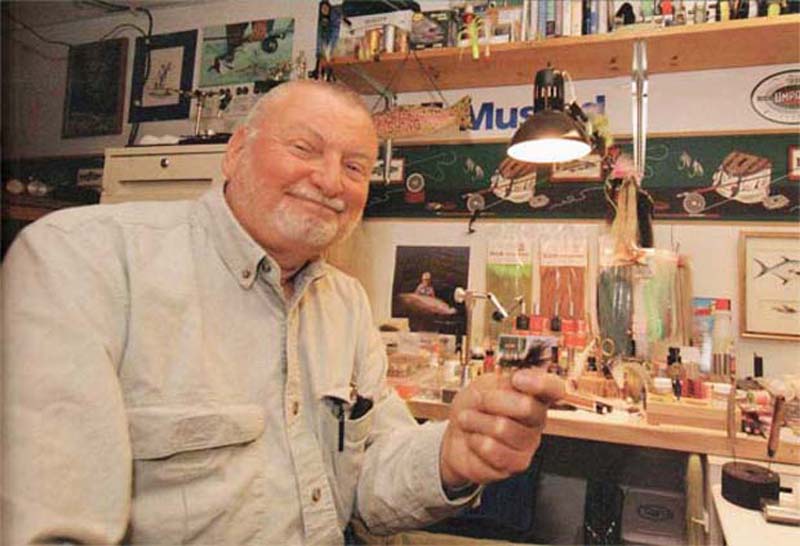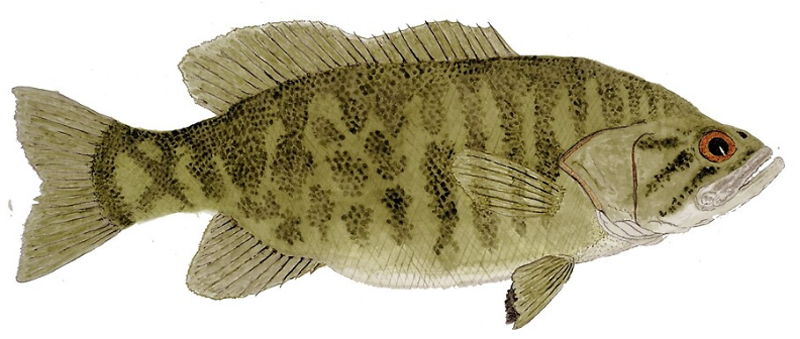
Russell Blessing holding a Wooly Bugger. Photo by Fly Rod + Reel.
Smallmouth bass, redfish, all trouts, snook, stripers, and more are registered addicts of the right BUGGER
By Skip Clement
Perhaps not so strangely, but strangely nonetheless is that the most productive fly ever invented, the Woolly Bugger has hardly an author well-known or associated with it. Even the magazine with everything you’ll ever need to know about fly fishing, Field & Stream, recently blew it completely. Well, almost entirely. John Merwin had an article titled The 25 Greatest Flies of All Time. He completely misses the boat by not knowing the author of the Woolly Bugger or its catch capabilities – just calls it a trout streamer. Well, he got part of it right – “best 25” so we can leave it at that.
Russell Blessing
A Harrisburg, Pennsylvania fly tier, Russell Blessing tied the first “Buggers.” He added a marabou tail to a Woolly Worm fly, to help suggest a swimming movement as the fly was retrieved in the water. He found that even if fished dead-drift, the fly still had movement. The Woolly Worm is an ancient fly found in Izaak Walton’s 1653 book “The Compleat Angler.” Russell’s original Woolly Bugger had a black marabou tail, and a black hackled olive chenille body.
He had designed it for fishing smallmouth bass in the streams near his home. He tried to imitate the dobsonfly larvae [Corydalus cornutus – known as hellgrammite].
Yes, you’re bored. Heck, you can buy them for $1.50 each, and if you do tie them, you know it’s easier than turning a doorknob. But if you think about it, you can catch just about anything that swims if you get the size right, color, and can swim it correctly. For size, conventional wisdom is #4 thru #12, color is olive, which is not always agreed with [I like black]. Still, it is the standard, and for swimming, whatever gets eaten, which for a few friends and me has always been sub-surface, start and stop – anything to get the marabou swishing -doing its thing.

Harrisburg, Pennsylvania’s Russell Blessing’s target for his new fly, Woolly Bugger, was the smallmouth bass, but it turned out to be virus-like and attracted just about everything. Thom Glace, a neighbor of Blessing’s, but from a different er [Mechanicsburg, PA], is the famous watercolorist and award-winning artist providing the smallmouth bass and other illustrations for this story.
Getting out of the minor leagues
In 1967 on a hot August afternoon, fly fishing journalist Barry Beck was having a hard time getting the fish to bite on the Little Lehigh River in Pennsylvania. Other fly fishermen nearby were also having the same problem, that is all except one, Russ Blessing. In 30 minutes, he netted four nice trout. Barry went over and asked what fly he was using. Barry was shocked to find it was a streamer. This type of fly typically was not very productive on the Lehigh River and especially in August. Russ, a true gentleman fly fisherman who was always willing to share his knowledge of flyfishing and fly-tying, gave Barry one of his Woolly Buggers to try. Barry’s luck changed, and he started to catch trout. Barry was so impressed that when he met Russ in the parking area just as he was going home, he asked for more information about the fly.

Take a dozen with you, all a little differently tied, and different in color and size.
The original version was black
Barry published an article on Russell Blessing’s wondrous Woolly Bugger in 1984. The rest is history. It became so popular that it is now an American standby. Woolly Buggers catch trout, bass, and salmon in both Atlantic and Pacific rivers, steelheads, and even saltwater flats dwellers.
It would not be an exaggeration to say that there is hardly a fish swimming that could not be caught with a Woolly Bugger. The Woolly Bugger may not be a glamorous fly, but it deserves to be in everyone’s fly box for all kinds of fly fishing, from warm water to saltwater. Russ Blessing retired in 1996, and when asked what he now did with all his spare time, he replied, “fish.”





